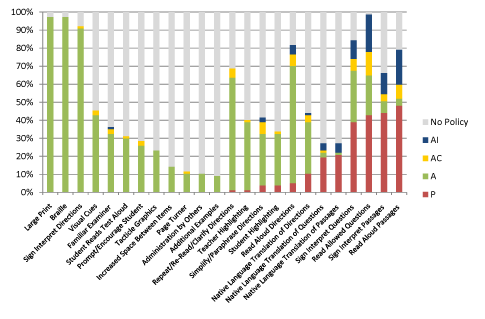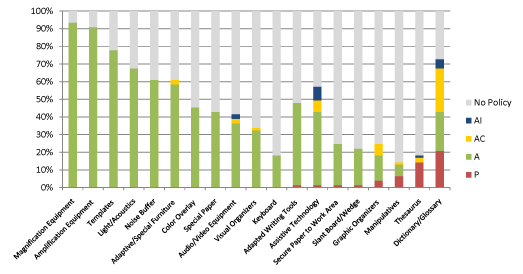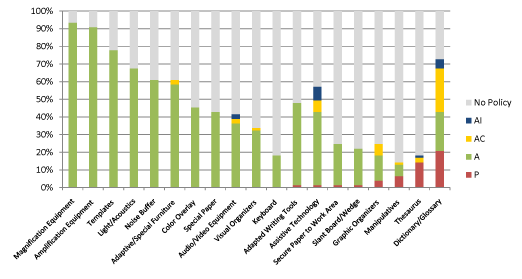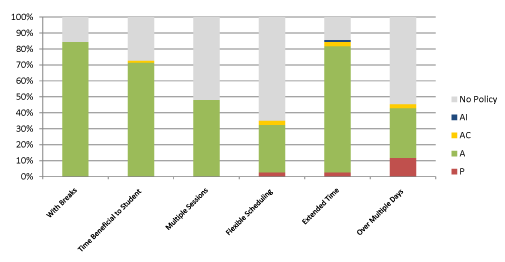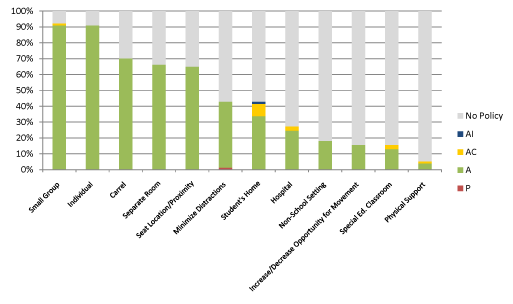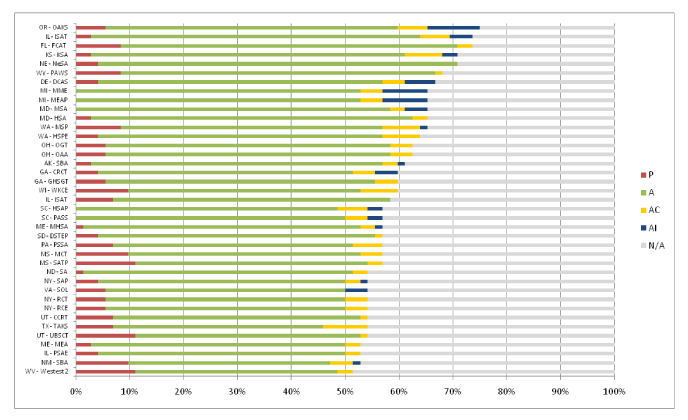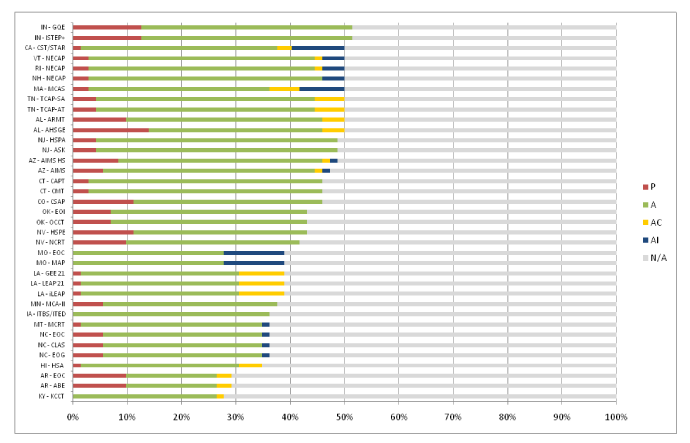Accommodations for State Reading Assessments: Policies Across the NationMartha L. Thurlow and Jenna Larson September 2011 All rights reserved. Any or all portions of this document may be reproduced and distributed without prior permission, provided the source is cited as: Thurlow, M. L., & Larson, J. (2011). Accommodations for state reading assessments: Policies across the nation. Minneapolis, MN: University of Minnesota, Partnership for Accessible Reading Assessment. Table of ContentsIntroductionIn the early 1990s, students with disabilities rarely were included in state assessments (Shriner, Spande, & Thurlow, 2003), due in part to the lack of policies about assessment participation and accommodations (Thurlow, Ysseldyke, & Silverstein, 1995). When the Individuals with Disabilities Education Act (IDEA) was reauthorized in 1997, it required that students with disabilities be included in state assessment programs, with accommodations as appropriate. Since that time, the goal has been to assure that students with disabilities have the same access to assessments as students without disabilities. When IDEA was reauthorized in 2004, further clarification about accommodations was provided. First, states were required to develop accommodation policies for their assessments used for school accountability purposes. Second, they were required to report the number of students using accommodations each year via their Annual Performance Reports submitted to the U.S. Department of Education (Altman, Thurlow, & Vang, 2010). When the Elementary and Secondary Education Act (ESEA) was reauthorized in 2001 as the No Child Left Behind (NCLB) Act, the participation of students with disabilities in state assessments, with accommodations as appropriate, was reinforced and strengthened. NCLB created consequences for the results of state assessments and put into place a new era of accountability in education. Under NCLB, education systems were and still are responsible for the achievement of all students, including students with disabilities. Proficient achievement is measured by a student’s score on the state’s assessment. One major result of this national push for accountability was the realization that it was often unknown whether scores from assessments taken with accommodations were accurate measures of how students with disabilities performed (Geisinger, 2007). Accommodated large-scale state testing is one of the primary ways that states include students with disabilities in accountability measures today (Altman et al., 2010), so it is essential that the scores are accurate (Elliott, 2007). The validity of assessment results is critical, leading the U.S. Department of Education to develop regulations to clarify that only accommodated assessments that produce valid results could be included in NCLB accountability (U.S. Department of Education, 2007). Some researchers and policymakers recommend that only accommodations that are known to produce valid results should be available to students with disabilities (Pullin, 2007). Top of Page | Table of Contents DefinitionsAn assessment accommodation is a change in the materials or procedures used for testing that does not change the construct that a test is intended to measure (Lazarus, Thurlow, Lail, & Christensen, 2009). Some researchers suggest identifying barriers to access that are construct-irrelevant—they affect a score but are not a component of the construct of interest for the assessment. Braden and Joyce (2008) suggest that the individual’s disability requires that the accommodation be in place in order to remove construct irrelevance. In other words, accommodations are needed to obtain an accurate measure of that individual’s knowledge and skills. When an accommodation is appropriate and produces valid results for a student, it also produces a better assessment experience for the student than a non-accommodated test (Laitusis, 2007). The term “modification” has been used to clarify the difference between changes in assessment procedures and materials that produce valid results and those that do not (Thurlow, Lazarus, & Christensen, in press). The scores yielded from an accommodated assessment are comparable to non-accommodated scores because the construct remains the same. In contrast, a modification is considered to remove essential aspects of the construct being tested, thereby resulting in construct underrepresentation (Braden & Joyce, 2008) or changes in the construct. Because a modification changes the construct of the test, the scores from that administration do not produce valid results, nor do they produce results that are comparable to the scores of other students. Although the field has adopted the distinction between accommodations and modifications, a distinction recognized in the revision of the Standards for Educational and Psychological Testing (AERA, APA, NCME, 2011), the U.S. Department of Education retains the use of only the term “accommodations.” Still, it makes the distinction by using the phrases “accommodations that produce valid results” and “accommodations that produce invalid results.” These distinctions sound clear, yet determining which changes in procedures and materials produce valid results and which produce invalid results is not so easily determined. Research on the effects of accommodations has been a primary avenue for determining which test changes produce valid and comparable results and which do not. Research on Effects of AccommodationsFor some time, it has been argued that a research base is needed to address the validity of results from accommodated assessments (Laitusis, 2007). One approach to establishing that an accommodation produces valid results is what Fuchs and Fuchs (1999) called “differential boost.” Differential boost occurs when an accommodation increases the scores of students with the targeted disability at a statistically higher level than the scores of students without that disability, compared to their scores respectively without an accommodation. They proposed that in order to consider results from an accommodation valid, one must prove that the accommodation affects the scores of students with disabilities significantly more than the scores of students without disabilities. Sireci, Scarpati, and Li (2005) examined accommodations using the “interaction hypothesis.” This hypothesis proposes that there will be an interaction between disability status and test format. Students with and without disabilities are assessed with and without accommodations, to see whether the testing format results in different performances for students with disabilities but not for students without disabilities. The ultimate difference between the two is that differential boost allows all scores to increase as long as the scores of students with disabilities have a larger increase; the interaction hypothesis states that only the scores of the students with disabilities should increase with the use of an accommodation. Both the differential boost and interaction hypothesis approaches are used in research on the effects of accommodations. Both approaches look for the effect on results of using an accommodation—either to see an effect only for students with disabilities (interaction hypothesis) or to see a greater effect for students with disabilities (differential boost). The National Center on Educational Outcomes (NCEO) provides an accommodations research bibliography (see http://apps.cehd.umn.edu/nceo/accommodations/), and every two or three years summarizes the research (see Cormier, Altman, Shyyan, & Thurlow, 2010; Johnstone, Altman, Thurlow, & Thompson, 2006; Thompson, Blount, & Thurlow, 2002; Zenisky & Sireci, 2007). This information is across all content areas and grade levels. Accommodations for Reading StudiesFor this report we gathered accommodations research conducted using reading assessments involving some of the most controversial accommodations (Thurlow et al., in press). We looked at studies published after 2005. Using the NCEO accommodations bibliography in conjunction with the ERIC database, 13 studies were found that met the criteria. In addition to differential boost and interaction hypothesis methods, these studies also used differential item functioning and factor analysis to determine the validity of results from tests where accommodations were used (Laitusis, 2007). Out of the 13 studies, 9 included the read aloud accommodation. Four of the studies looked only at the read aloud, while five included the read aloud and either extended time or resource guides to accompany the read aloud. Of those nine studies, six studies displayed evidence that the read aloud accommodation produced valid results for students with disabilities (Cook, Eignor, Sawaki, Steinberg, & Cline, 2010; Cook, Eignor, Steinberg, Sawaki, & Cline, 2009; Fletcher et al., 2006; Fletcher et al., 2009; Huynh & Barton, 2006; Laitusis, 2010). Two studies indicated that the scores from students who used the read aloud accommodation were not comparable to scores from students who had no accommodations (Bolt & Ysseldyke, 2006; Randall & Engelhard, 2010b). One study found a differential boost for the read-aloud accommodation in 4th grade but not in 7th grade (Randall & Engelhard, 2010a). In addition to information about the read-aloud accommodation, two of the nine studies also researched the effects of other accommodations in conjunction with the read-aloud accommodation. Randall and Engelhard (2010a) found that although the read-aloud accommodation gave some students with disabilities a differential boost in scores, resource guides actually resulted in lower scores for students with disabilities but did not affect the scores of students without disabilities. In addition, Fletcher et al. (2009) found that when using the read aloud, a two day administration offered a differential boost over a one day administration for students with disabilities. The other three studies that included an accommodation in conjunction with the read aloud did not offer individual analyses for those accommodations (Cook et al., 2010; Fletcher et al., 2006; Randall & Engelhard, 2010b). Although the majority of studies of accommodations for reading assessments focused on the validity of the read-aloud accommodation, 4 of the 13 studies analyzed the validity of results with different accommodations. Stone, Cook, Laitusis, and Cline (2010) conducted a study that concluded that Braille and large print versions of a large scale reading assessment were similar in their item functioning to non-accommodated versions of the test. On the other hand, Lewandowski, Lovett, and Rogers (2008) examined the accommodation of extended time and found that students without disabilities benefited more from extra time than students with disabilities. The final two studies used differential boost to examine the validity of results when individual accommodations were given to students with disabilities based on their Individualized Education Programs (IEPs). Students with disabilities were matched to students without disabilities with similar characteristics. Lang, Elliott, Bolt, and Kratchowill (2008) indicated that there was a greater increase in scores for students with disabilities when tested with their IEP accommodations than for students without disabilities. Likewise, Kettler et al. (2005) found a differential boost, but only for 4th grade. There was no statistical difference for 8th grade students (2005). State Assessment Accommodation PoliciesResearchers conducted these studies to ascertain the validity of results when certain accommodations were used for state reading assessments. Only a few accommodations are subjected to research. Thus, states must rely on other information to set their accommodation policies. NCEO has tracked and summarized accommodation policies for more than a decade (Christensen, Lazarus, Crone, & Thurlow, 2008; Christensen, Scullin, Braam, & Thurlow, 2011; Clapper, Morse, Lazarus, Thompson, & Thurlow, 2005; Lazarus, Thurlow, Lail, Eisenbraum, & Katon, 2006). In addition, Lazarus et al. (2009) analyzed several specific state assessment policies from 1993-2005. Three major changes occurred in policy construction during that time; these changes affect accommodation policies today. First, policies transitioned from a purpose of leveling the playing field for students with disabilities to ensuring that all test scores are valid measures of student’s knowledge and skills. The transition of accommodation purposes led to some changes in the amount of detail included in policies. Because of new questions about validity, policies became more nuanced and specific about accommodation use. These changes were not necessarily the reflection of advances in research or an increase in the knowledge base on validity and accommodations. Instead, they often were based on decisions not supported by data. Second, standardized state testing relied more on technology, and technological accommodations were more accepted over time. With this advancement in technology, states were able to change from a standard paper and pencil administration to a computer-based administration of their large scale assessments. Multiple studies have looked at the comparability of computer-based testing versus paper and pencil administration and in general have found that the two versions yield equivalent scores (Higgins, Russell, & Hoffman, 2005; Keng, McClarty & Davis, 2008; Kingston, 2009; Kim &Huynh, 2008; Kim & Huynh, 2010; Korbin & Young, 2003). What had yet to be discussed in the field was whether this increase in technology was changing the definitions of certain accommodations. For instance, if highlighting was an allowed accommodation, how did a student on a computer use that highlighter (see also NCEO, 2011)? Third, Lazarus et al. (2009) noted that more states have been opting for a universal design approach to assessments where accommodations are built into the tests themselves. The ultimate objective of universal design in large-scale assessment is to create a test that is accessible to the largest number of test takers. In other words, universal design does not just benefit students with disabilities but also other students taking the test. Items that are better designed are better measures of the knowledge and skills for all students. Better designed items can be constructed by removing construct-irrelevant variance and creating simplified item formatting and design in tests (Thompson, Johnstone, & Thurlow, 2002; Thompson, Thurlow, & Malouf., 2004). Current State Assessment PolicyThe content of the assessment drives the validity of results when accommodations are used. Certain accommodations produce valid results for one test but not another. For example, the read aloud accommodation is often considered appropriate for math assessments but not reading assessments (Bolt & Ysseldyke, 2006). The purpose of this report is to summarize accommodation policies for the content area of reading. Because of the increase in the use of computer-based assessments, we also examined whether reading assessment policies varied as a function of test format (Dolan, Hall, Banerjee, Chun, & Strangman, 2005). Research QuestionsTwo research questions are addressed in this report:
Top of Page | Table of Contents MethodWe collected accommodation policies for state reading assessments used for school accountability. Using Appendix C from the 2008-2009 report on public reporting of assessment data (Thurlow, Bremer, & Albus, 2011), a list of state reading assessments was generated. Only assessments that were used by the state for school accountability reporting under the 2001 Elementary and Secondary Education Act (2002) were included in this list. For each test, the accommodations policy for reading assessments (either the reading test or the reading section of an English/Language Arts assessment) was obtained from the NCEO Data Viewer for the 2008-2009 school year (see www.data.nceo.info). When the Data Viewer was not specific to the test or content area, supplemental data were collected from the state. In these cases, the information was located by researching that state’s department of education website for test manuals and accommodation policy reports. A list of the supplemental resources is provided in Appendix A. Examination of the states’ accommodations policies for reading assessments revealed a total of 72 accommodations listed by the states. These were organized into five categories—presentation, equipment/materials, response, scheduling/timing, and setting. The categories are explained in Table 1. Table 1. Accommodation Categories and Descriptions
The accommodations in each state’s assessment accommodation policy were coded into one of the five categories. Then, each accommodation was designated as Allowed, Prohibited, Allowed in Certain Circumstances, Allowed with Implications for Scoring, or No Policy. Table 2 presents the definitions for each of these policy types. Table 2. Accommodation Policy Type and Descriptions
After each state reading assessment policy was coded, we separated the tests into assessments administered using paper/pencil and assessments administered using computer-based testing. Computer-based assessments were identified using information in Appendix B of the NCEO report on computer-based testing (Thurlow, Lazarus, Albus, & Hodgson, 2010). We then compared the two formats of accommodation policies for reading assessments. Top of Page | Table of Contents ResultsAccommodations PoliciesWe combined the policies of all state assessments to present an overall picture of the policy type (giving us a sense of the acceptability of each accommodation) for reading assessments across all states. Accommodation policies are specific to each state assessment. If a state had two state assessments, the state would have an accommodation policy for each one. The data reflect all accommodation policies (20 states had two assessments, 3 states had three assessments) for all states for the listed accommodations (n=72). Appendix B provides a summary of each accommodation policy for each state assessment. We also defined “controversial accommodations” to be those for which there was variability in policy types, especially those with both Allowed and Prohibited policies for the same accommodation. Not all state assessments had explicit policies on the accommodations identified for reading assessments. No Policy indications are included to show the extent to which controversial accommodations are spread across the state assessments or limited to fewer state assessments. Presentation AccommodationsFigure 1 portrays presentation accommodation policies from those state assessments with the fewest policies prohibiting an accommodation (on the left) to those with the greatest number of state assessments prohibiting them (on the right). The most controversial accommodations (on the far right in the figure) included reading questions, reading passages, sign interpretation of questions, and sign interpretation of passages. The read aloud passages accommodation was prohibited (P) by the majority of state assessment policies (n=37), followed by state assessments that did not include the scores in their accountability reporting (AI) when this accommodation was used (n=15). Only three state assessments allowed the read aloud passages accommodation with no implications for scoring (A). Figure 1. Presentation Accommodation Policies for Reading Assessments
Equipment and Materials AccommodationsFigure 2 shows equipment and materials accommodations for reading assessments, from least to most controversial. Accommodations on the far left, magnification and amplification equipment, were allowed by about 92% of state assessments and prohibited by none. The two most controversial accommodations in the equipment and materials category were the thesaurus and dictionary/glossary. State assessments were fairly evenly split on the policies that were applied to the dictionary/glossary: prohibited (n=16), allowed (n=17), allowed in certain circumstances (n=19), had no policy (n=21). Most of the state assessments that allowed the use of the dictionary/glossary in certain circumstances indicated that the glossary must be provided by the state. Figure 2. Equipment and Materials Accommodation Policies for Reading Assessments
Response AccommodationsResponse accommodations for reading assessments are shown in Figure 3. On the far left of the graph, it is evident that the proctor/scribe accommodation was allowed for a large number of state reading tests (n=66), although for some state assessments, it was only allowed in certain circumstances (n=5) or with implications for scoring (n=2). In contrast, the Spell Checker/Assistance accommodation, on the far right, was prohibited for many more state assessments than for which it was allowed. Still, it was allowed in about 17% of state assessment policies, and accepted under conditions in another 10%. Figure 3. Response Accommodation Policies for Reading Assessments
Scheduling/Timing AccommodationsScheduling/timing accommodations are shown in Figure 4. For the most part, these accommodations are less controversial than other categories of accommodations. Administering the test over multiple days, on the far right side of the graph, was the most controversial. It was prohibited for 11% of the state reading assessments. Figure 4. Scheduling/Timing Accommodation Policies for Reading Assessments
Setting AccommodationsFigure 5 shows states’ policies for setting accommodations for reading assessments. This category of accommodations had only one accommodation that was prohibited for any state assessment—minimize distractions. On the whole, setting accommodations comprised the least controversial group of accommodations. If the state assessment had a defined policy, setting accommodations were, for the most part, allowed by that assessment. In some instances, the accommodation was allowed under certain circumstances. Many state assessments did not have a policy for these accommodations. For example, providing support during testing was addressed in policies for only four assessments. Figure 5. Setting Accommodation Policies for State Reading Assessments
Accommodations for Computer-based Tests and Paper/Pencil TestsWe re-organized the accommodation policy data to address our second research question, whether different accommodation policies were associated with the format of the assessment (computer based versus paper/pencil). Figure 6 presents the overall accommodation policy type data for paper/pencil reading assessments. Figure 7 presents the overall accommodation policy type data for computer-based reading assessments. Figure 6. State Reading Assessment Accommodation Policies Across All State Paper/Pencil Reading Assessments
Figure 7. State Reading Assessment Accommodation Policies Across All State Computer-based Reading Assessments
Figures 6 and 7 suggest that there are minor differences in accommodation policies based on test format. These differences generally occurred in those accommodations that were allowed and those for which a state assessment had no policy. The other three policy types (prohibited, allowed in certain circumstances, allowed with implications for scoring) did not differ for the two reading assessment formats. In general, the percentage of accommodations allowed was higher for computer-based formats (49%) than for paper/pencil formats (40%). On the other hand, no policy accommodations were higher for paper/pencil formats (50%) than for computer-based formats (41%) for reading assessments. Top of Page | Table of Contents DiscussionAs the findings of this study reveal, accommodation policies for state reading assessments vary widely, both in the number of accommodations addressed in each policy and the acceptability of those accommodations. It is clear that there is still much debate about accommodations and how they affect the construct of reading during testing. Some state assessment policies categorize similar accommodations differently, meaning that some policymakers believe an accommodation produces valid results while some do not. A question to ask is how and why each state interprets the accommodations the way they do. Is it possible that one state views an accommodation as changing the construct of the test while another does not? Is it that the constructs tested are different or is something else going on? A number of the differences in policies may be due to the fact that the research base on accommodations is lacking. The differential boost hypothesis explicated by Fuchs and Fuchs (1999) is time and resource intensive. Studies have not been implemented to check the validity of results for all available accommodations. In some cases, reliance on a careful analysis of the intended construct and the perceived effect of an accommodation may be appropriate and sufficient. In other cases research is needed. It seems that providing no policy may not be the best option. In the past five years, the majority of studies on the effects of accommodations focused on a single accommodation, reading the test aloud. Overall, there were 13 studies conducted since 2005, all with varying results. Research seems not to be the way that state assessment accommodation policies are being set. Most accommodations are presentation accommodations. We found large differences in perceived acceptability of these accommodations for state reading assessments. Large print and Braille were allowed on almost all state assessments and prohibited in none. On the other hand, reading sections of the test aloud was a highly controversial accommodation. This is not surprising considering the research base for this accommodation across states. This finding is consistent with the variability in research findings, and probably is related to the debate about the purpose of reading assessments (to assess decoding and comprehension or only comprehension). Next most prevalent in frequency were equipment and materials accommodations. In this category, using a dictionary or glossary was equally split between being prohibited and allowed, with allowed under certain circumstances the next most frequent policy type. These differences may be due to the differences in test purpose. States might decide that a reading test that measures vocabulary should not allow a dictionary, whereas one that measures decoding skills might. In the response accommodations category, allowing a proctor/scribe was among the more controversial accommodations. The data suggest a concern about the potential influence of a proctor or scribe on scores in a way that compromises obtaining an accurate measure of students’ knowledge and skills. Spell checker was also controversial for reading tests, perhaps more often in relation to constructed responses. The scheduling and timing accommodation category had two controversial accommodations—giving a student extra time and testing over multiple days. In the case of giving a student extended time, most often that accommodation was prohibited on state tests that had explicit timing requirements. Notable is the fact that extended time was prohibited for only two assessments. For multiple days testing, controversy seemed to be related to security concerns. One reason the multiple day accommodation was prohibited more often than the extended time accommodation may be because item security is an issue for every assessment and not just timed assessments. The setting accommodation category had very few controversial accommodations. A number of these accommodations were ones for which states had no policy. It is possible that the lack of policies is related to states’ attempts to use more universal design approaches and best testing practices for all students, rather than relying on accommodations. In reviewing state policies for reading assessments, we noted that in some cases, states developed a separate policy for each content area, while others used a single policy for all tests regardless of content. An accommodation policy based on reading content only should look different from one based on reading and math. For example, the read-aloud accommodation is accepted on most math tests but is controversial for reading tests. It is also possible that some state reading assessments were used for different purposes. Some may have focused explicitly on comprehension only whereas others may have blended comprehension and decoding. Some may have been high stakes assessments for students (e.g., grade promotion, graduation), with different accommodation policies related to these purposes. Because of the increasing popularity of administering assessments on computers, we also examined accommodations for reading assessments as a function of format—computer-based versus paper/pencil. We found that on the whole, a greater percentage of computer-based reading assessment policy accommodations were addressed (coded as other than No Policy) than policies for paper/pencil tests. In addition, of those extra accommodations that are addressed, the policy tended to allow those accommodations. One hypothesis of this study was that computer-based testing would increase the use of universal design in state reading assessments and this could account for possible differences in state policies. For example, on a computer-based test, a highlighting function may be available to everyone, whereas on a paper and pencil administration, highlighting is only allowed for students with that accommodation. These data, however, seem to suggest that this did not occur. It would make sense that with greater universal design there would be less need for accommodation policies, and therefore, a greater percentage of no policy categorizations on the computer-based test. But in actuality, the opposite happened. More accommodations were examined and allowed for computer-based testing. In contrast to the hypothesis, two alternative explanations for this finding are: (a) states with computer-based testing have a greater need to clarify accommodations more often than states with paper and pencil administrations, and (b) states with computer-based assessments had more resources allocated to accountability assessments in general. It appears that states may have been translating accommodations from paper and pencil tests to the computer instead of building those accommodations into the test itself. With the creation of a new format of testing, issues that may not have been an issue before now become relevant. For example, a non-controversial accommodation like large-print text has to be re-formatted on the computer. Questions that were never addressed by paper and pencil assessments (e.g., should the font size be controlled for the test taker or should all font sizes be adjustable), needed to be answered. It is possible that the accommodations that were not used as frequently were not examined in state policies that have limited resources. States with more time and financing may have had more ability to examine these uncommon accommodations. Consequently, when they were examined, the number of no policy categorizations decreased. Still, this does not explain why the accommodations that had no policy were overwhelmingly then categorized as allowed. States with greater resources may have had the time to code all of these accommodations as allowed. In this case, the no policy categorizations would decrease while the allowed categorizations would increase, which was supported by the data. More research is needed to further investigate these hypotheses. Top of Page | Table of Contents ConclusionThis analysis of states’ accommodation policies for their reading assessments indicates the importance of understanding the intended constructs to be assessed by the state reading assessment. Policies indicate that there are different perspectives on the constructs, and that further explication of the content to be assessed would be beneficial. Top of Page | Table of Contents ReferencesAERA, APA, NCME. (2011). Draft of the revised standards for educational and psychological testing. Washington, DC: Authors. Altman, J., Thurlow, M., & Vang, M. (2010). Annual performance report: 2007-2008 state assessment data. Minneapolis, MN: University of Minnesota, National Center on Educational Outcomes. Available at: www.nceo.info/OnlinePubs/APRreport 2007-2008.pdf Bolt, S. E., & Ysseldyke, J. E. (2006). Comparing DIF across math and reading/language arts tests for students receiving a read-aloud accommodation. Applied Measurement in Education, 19(4), 329-355. Braden, J. P., & Joyce, L. B. (2008). Best practices in making assessment accommodations. In A. Thomas & J. Grimes (Eds.), Best practices in school psychology V (Vol. 2). Bethesda, MD: The National Associations of School Psychologists. Christensen, L. L., Lazarus, S. S., Crone, M., & Thurlow, M. L. (2008). 2007 state policies on assessment participation and accommodations for students with disabilities (Synthesis Report 69). Minneapolis, MN: University of Minnesota, National Center on Educational Outcomes. Christensen, L. L., Scullin, S., Braam, M., & Thurlow, M. L. (2011). 2009 state policies on assessment participation and accommodations for students with disabilities (Synthesis Report 83). Minneapolis, MN: University of Minnesota, National Center on Educational Outcomes. Clapper, A. T., Morse, A. B., Lazarus, S. S., Thompson, S. J., & Thurlow, M. L. (2005). 2003 state policies on assessment participation and accommodations for students with disabilities (Synthesis Report 56). Minneapolis, MN: University of Minnesota, National Center on Educational Outcomes. Cook, L., Eignor, D., Sawaki, Y., Steinberg, J., & Cline, F. (2010). Using factor analysis to investigate accommodations used by students with disabilities on an English-language arts assessment. Applied Measurement in Education, 23(2), 187-208. Cook, L., Eignor, D., Steinberg, J., Sawaki, Y., & Cline, F. (2009). Using factor analysis to investigate the impact of accommodations on the scores of students with disabilities on a reading comprehension assessment. Journal of Applied Testing Technology, 10(2). Cormier, D. C., Altman, J. R., Shyyan, V., & Thurlow, M. L. (2010). A summary of the research on the effects of test accommodations: 2007-2008 (Technical Report 56). Minneapolis, MN: University of Minnesota, National Center on Educational Outcomes. Dolan, R. P., Hall, T. E., Banerjee, M., Chun, E., & Strangman, N. (2005). Applying principles of universal design to test delivery: The effect of computer-based read-aloud on test performance of high school students with learning disabilities. The Journal of Technology, Learning, and Assessment, 3(7). Elliott, S. N. (2007). Selecting and using testing accommodations to facilitate meaningful participation of all students in state and district assessments. In C.C. Laitusis & L.L. Cook (Eds.), Large-scale accommodations: What works? (pp. 1-9). Arlington, VA: Council for Exceptional Children. Fletcher, J. M., Francis, D. J., Boudousquie, A., Copeland, K., Young, V., Kalinowski, S., & Vaughn, S. (2006). Effects of accommodations on high-stakes testing for students with reading disabilities. Exceptional Children, 72(2), 136-150. Fletcher, J. M., Francis, D. J., O’Malley, K., Copeland, K., Mehta, P., Caldwell, C. J., Kalinowski, S., Young, V., & Vaughn, S. (2009). Effects of a bundled accommodations package on high-stakes testing for middle school students with reading disabilities. Exceptional Children, 75(4), 447-463. Fuchs , L. S., & Fuchs, D. (1999). Fair and unfair testing accommodations. School Administrator, 56(10), 24-29. Geisinger, K. F. (2007). Preface. In C. Cahalan Laitusis & L.L. Cook (Eds.), Large-Scale Accommodations: What Works? (pp. ix-xi). Arlington, VA: Council for Exceptional Children. Higgins, J., Russell, M., & Hoffman, T. (2005). Examining the effect of computer-based passage presentation on reading test performance. The Journal of Technology, Learning, and Assessment, 3(4). Huynh, H., & Barton, K. E. (2006). Performance of students with disabilities under regular and oral administrations of a high-stakes reading examination. Applied Measurement in Education, 19(1), 21-39. Johnstone, C. J., Altman, J., Thurlow, M. L., & Thompson, S. J. (2006). A summary of research on the effects of test accommodations: 2002 through 2004 (Technical Report 45). Minneapolis, MN: University of Minnesota, National Center on Educational Outcomes. Kettler, R. J., Niebling, B. C., Mroch, A. A., Feldman, E. S., Newell, M. L., Elliot. S. N., Kratochwill, T. R., & Bolt, D. M. (2005). Effects of testing accommodations on math and reading scores: An experimental analysis of the performance of students with and without disabilities. Assessment for Effective Intervention, 31(1), 37-48. Keng L., McClarty K. L., & Davis L. L. (2008). Item-level comparative analysis of online and paper administrations of the Texas Assessment of Knowledge and Skills. Applied Measurement in Education, 21(3), 207-226. Kim, D. H., & Huynh, H. (2008). Computer-based and paper-and-pencil administration mode effects on a statewide end-of-course English test. Educational and Psychological Measurement, 68(4), 554-570. Kim, D. H., & Huynh, H. (2010). Equivalence of paper-and-pencil and online administration modes of the statewide English test for students with and without disabilities. Educational Assessment, 15(2), 107-121. Kingston, N. M. (2009). Comparability of computer- and paper-administered multiple-choice tests for K-12 populations: A synthesis. Applied Measurement in Education, 22(1), 22-37. Laitusis, C. C. (2007). Research designs and analysis for studying accommodations on assessments. In C. C. Laitusis & L. L. Cook (Eds.), Large-scale accommodations: What works? (pp. 67-79). Arlington, VA: Council for Exceptional Children. Laitusis, C. C. (2010). Examining the impact of audio presentation on tests of reading comprehension. Applied Measurement in Education, 23(2), 153-167. Lang, S. C., Elliott, S. N., Bolt, D. M., & Kratchowill, T. R. (2008). The effects of testing accommodations on student’s performances and reactions to testing. School Psychology Quarterly, 23(1), 107-124. Lazarus, S. S., Thurlow, M. L., Lail, K. E., & Christensen, L. (2009). A longitudinal analysis of state accommodations policies: Twelve years of change, 1993-2005. Journal of Special Education, 43(2), 67-80. Lazarus, S. S., Thurlow, M. L., Lail, K. E., Eisenbraun, K. D., & Kato, K. (2006). 2005 state policies on assessment participation and accommodations for students with disabilities (Synthesis Report 64). Minneapolis, MN: University of Minnesota, National Center on Educational Outcomes. Lewandowski, L. J., Lovett, B. J., & Rogers, C. L. (2008). Extended time as a testing accommodation for students with reading disabilities: Does a rising tide lift all ships? Journal of Psychoeducational Assessment, 26(4), 315-324. NCEO. (2011). Don’t forget accommodations! Five questions to ask when moving to technology-based assessments (NCEO Brief #4). Minneapolis, MN: University of Minnesota, National Center on Educational Outcomes. Pullin, D. (2007). Accommodations in testing: Law, policy, and practice. In C.C. Laitusis & L.L. Cook (Eds.), Large-scale accommodations: What works? (pp. 37-49). Arlington, VA: Council for Exceptional Children. Randall, J., & Engelhard, G., Jr. (2010a). Performance of students with and without disabilities under modified conditions: Using resource guides and read-aloud test modifications on a high-stakes reading test. The Journal of Special Education, 44(2), 79-93. Randall, J., & Engelhard, G., Jr. (2010b). Using confirmatory factor analysis and the Rasch model to assess measurement invariance in a high stakes reading assessment. Applied Measurement in Education, 23(3), 286-306. Shriner, J. G., Spande, G. E., & Thurlow, M. L. (2003). State special education outcomes 1993: A report on state activities in the assessment of educational outcomes for students with disabilities. Minneapolis, MN: University of Minnesota, National Center on Educational Outcomes. Sireci, S. G., Scarpati, S. E., & Li, S. H. (2005). Test accommodations for students with disabilities: An analysis of the interaction hypothesis. Review of Educational Research, 75(4), 457-490. Stone, E., Cook L., Laitusis, C. C., & Cline, F. (2010). Using differential item functioning to investigate the impact of testing accommodations on an English-language arts assessment for students who are blind or visually impaired. Applied Measurement in Education, 23(2), 132-152. Thompson, S., Blount, A., & Thurlow, M. (2002). A summary of research on the effects of test accommodations: 1999 through 2001 (Technical Report 34). Minneapolis, MN: University of Minnesota, National Center on Educational Outcomes. Thompson, S., Johnstone, C. J., & Thurlow, M. L. (2002). Universal design applied to large scale assessments (Synthesis Report 44). Minneapolis, MN: University of Minnesota, National Center on Educational Outcomes. Thompson, S. J., Thurlow, M. L., & Malouf, D. (2004, May). Creating better tests for everyone through universally designed assessments. Journal of Applied Testing Technology, 10(2). See www.testpublishers.org/atp.journal.htm Thurlow, M. L., Bremer, C., & Albus, D. (2011). 2008-09 publicly reported assessment results for students with disabilities and ELLs with disabilities (Technical Report 59). Minneapolis, MN: University of Minnesota, National Center on Educational Outcomes. Thurlow, M. L., Lazarus, S. S., & Christensen, L. L. (in press). Accommodations for assessment. In B. Cook & M. Tankersley (Eds.), Effective practices in special education. Iowa City: Pearson. Thurlow, M., Lazarus, S. S., Albus, D., & Hodgson, J. (2010). Computer-based testing: Practices and considerations (Synthesis Report 78). Minneapolis, MN: University of Minnesota, National Center on Educational Outcomes. Thurlow, M. L., Ysseldyke, J. E., & Silverstein, B. (1995). Testing accommodations for students with disabilities. Remedial and Special Education, 16(5), 260-270. U.S. Department of Education. (2007, April 9). Final regulations. Federal Register, 72(67), 17748-17781. Zenisky, A. L., & Sireci, S. G. (2007). A summary of the research on the effects of test accommodations: 2005-2006 (Technical Report 47). Minneapolis, MN: University of Minnesota, National Center on Educational Outcomes. Top of Page | Table of Contents Appendix ASupplemental Resources to Data Viewer
* Students in these states all take the NECAP Assessment and follow the same participation guidelines. Top of Page | Table of Contents Appendix BPractice PaperFigure B-1 displays the breakdown of the accommodation policies by each state reading assessment. It is evident that some reading assessments had detailed accommodation policies (e.g., Oregon’s OAKS) and others were less detailed (e.g., Kentucky’s KCCT). Assessment policies for individual assessments ranged from addressing about 75% of possible accommodations to addressing less than 30%. It is notable that the percentages of prohibited and allowed policies were not necessarily related to each other. In other words, states with more prohibited accommodations did not necessarily have fewer allowed accommodations. The data in Figure B-1 also clearly show that states vary in the extent to which accommodations were prohibited. Not only are checks of the validity of results from individual accommodations necessary, but so is comparing different state policies to one another. A student receiving a fair assessment on one test but not on another is detrimental to the purpose of equality in testing for all students. Therefore, in addition to comparing each accommodation over all the states, we viewed the overall look of the state policy when combining all accommodations as important. State policies as a whole differed based on the state itself. Some states had extensive accommodation policies where they address almost all of the possible accommodations, while other states had very limited accommodations policies. Figure B-1. Accommodation Policies of each State Reading Assessment used for Accountability
|
